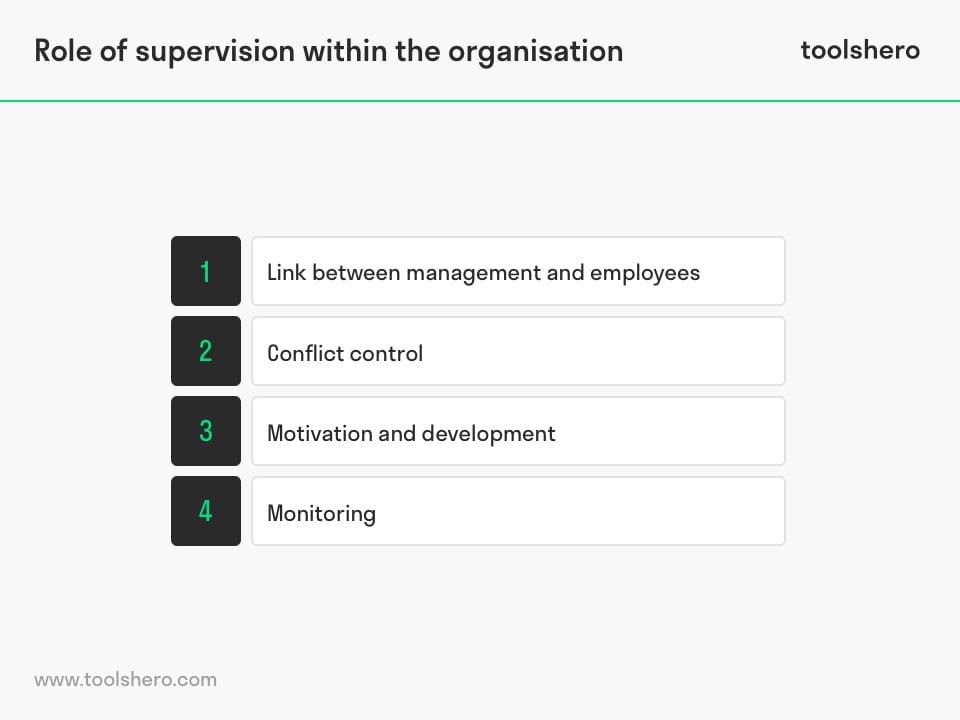Supervision: the basics and meaning

Supervision: this article provides a practical explanation of supervision. Next to what it is (definition and meaning), this article also highlights the difference between Supervision or Leadership, the role of it within an organisation and the topic illegitimate supervision. After reading, you will understand the basics of this leadership and management concept. Enjoy reading!
What is supervision?
There’s a certain saying: ‘That which hasn’t been inspected, hasn’t been completed.’ Inspecting, supervising, and overseeing are part of everyday business.
The term supervision comes from Latin, from the word “supervideo”. Super means “above”, and video means “I see”. Literally it therefore means overseeing something.
In pretty much all hierarchical organisations, people are supervised. This is necessary for an organisation to function, as are coordination and linking different business elements.
Definition and meaning of supervision
A general definition is that it’s a social process, a cooperative relationship between a leader and at least one other person in order to complete a specific activity.
The social process is a two-way street and is carried out to achieve an organisational goal through support and guidance.
Supervision is a continuous process in which motivation, performance and rewards, and leadership all play a role. The goal is to stimulate the professional growth of employees, to safeguard good quality, and to increase control.
Supervision or Leadership?
Supervision means overseeing something or someone. It also means leading, although supervision and leadership are two different concepts.
Leadership is the ability to effectively and responsibly handle employees, business processes and business programmes.
Leadership also means achieving organisational objectives. Supervising on the other hand is the activity, carried out by supervisors, for instance to track the productivity and progress of employees.
These employees are under the direct supervision of the supervisor. Supervising is a management activity, and supervisors have a management role in organisations.
In general, people distinguish between direct and indirect supervision.
Direct supervision
Direct supervision is a term that is used to refer to situations in which there is always a supervisor present.
In such cases, the supervisor oversees all activities that are being performed by the employees and continuously provides them with feedback and guidance.
Indirect supervision
Indirect supervision means that a supervisor isn’t present all the time. Although there still is a sense of authority, the supervisor is no longer responsible for individual employees, only for results.
The basic principles of supervision and leadership are similar. By only looking at supervising from a management perspective, aspects like personnel and objectives are ignored.
Leadership and Assertive Supervision
Lead, Guide and Develop your team!
The Role of Supervision Within the Organisation
The supervisor is always responsible for the performance of subordinates that work under his watch.
Supervisors should stimulate, improve, and develop employees when it comes to their knowledge and skills. It’s important that individual strengths and weaknesses are taken into consideration and that a personal action plan is formed.
The supervisor should also help employees develop the right attitude when it comes to work and their surroundings.
The role of a supervisor is a prominent one in many organisations.
The functions of a supervisor include:

Figure 1 – the 4 elements of supervision within an organization
Link between management and employees
The supervisor acts as a link between management and employees. The supervisor explains the idea or objective to the employees and takes any feedback from the employees back to management.
The supervisor also ensures that all plans and procedures are carried out in the way management wants it.
Conflict Control
Through the activities described above, the supervisor ensures clarity and unity within the department. This helps prevent conflicts and misunderstandings between employees, but also between employees and management.
The supervisor therefore plays an important role in resolving employee conflicts.
They need to handle the situation as adequately and effectively as possible.
Motivation and Development
The supervisor bears responsibility for completing the activity before the deadline by leading his team. This means they are motivated, which must be reflected in their communication with employees.
In order to make the team as effective as possible, good and experienced supervisors will plan brief moments to train or advise employees during working hours.
Monitoring
Supervision ensures that the performance that is expected is sufficient to achieve the objectives. During production or other activities, the supervisor carefully monitors performance and focus to keep them up.
Illegitimate Supervision
Illegitimate or forced supervision has been studied extensively in organisational settings. Even though employees are being supervised, there is still a lot that can happen.
Between employees, but between employees and the supervisors as well. This often leads to uncomfortable situations for people.
Workplace Inconsistencies
Workplace inconsistencies are strongly linked to abuse. Abuse can happen when supervisors ridicule employees, ignore them, or keep reminding them of poor performance in the past.
Bullying
Illegitimate supervision and workplace bullying are linked in the sense that most of the incidents related to people are caused by employee supervisors.
Social Pressure
Social undermining or pressure can be the result of poor supervision. Much research has been done into social pressure. Experts agree that a negative working environment has a direct relation to an employee’s mental health. Employees also tend to take a hostile working environment home with them in some way.
Now it’s your turn
What do you think? Are you familiar with this explanation of supervision? What do you think are the most important aspects to consider when supervising employees? Do you have any questions or comments or anything to add?
Share your experience and knowledge in the comments box below.
More information
- Bernard, J. M., Goodyear, R. K., & Bernard, J. M. (1992). Fundamentals of clinical supervision.
- Yun-sheng, W. (2001). Sergiovanni, Tepper, B. J. (2000). Consequences of abusive supervision. Academy of management journal, 43(2), 178-190.
- T. J., Starratt, R. J., & Cho, V. (1993). Supervision: A redefinition.
- Glickman, C. D., Gordon, S. P., & Ross-Gordon, J. M. (2001). Supervision and instructional leadership: A developmental approach. Allyn & Bacon/Longman Publishing, a Pearson Education Company, 1760 Gould Street, Needham Heights, MA 02494. Web site: https://www.abacon.com.
- Cogan, M. L. (1973). Clinical supervision (p. 14). Boston: Houghton Mifflin.
How to cite this article:
Janse, B. (2019). Supervision. Retrieved [insert date] from Toolshero: https://www.toolshero.com/leadership/supervision/
Original publication date: 02/28/2019 | Last update: 12/24/2023
Add a link to this page on your website:
<a href=”https://www.toolshero.com/leadership/supervision/”>Toolshero: Supervision</a>












